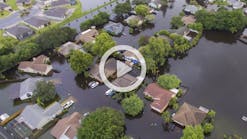About the author: Matt Previte is senior project sales and management for YSI Integrated Systems & Services. Previte can be reached at [email protected] or 727.565.2201 x 819.
Marine Corps Air Station (MCAS) Cherry Point, located in Havelock, N.C., has a runway system so extensive that the base served as an alternate emergency landing site for space shuttle launches out of Cape Canaveral, Fla. Since the air station was commissioned in May 1942, it has been a primary training and deployment center for countless military aviation units for all branches of the military, supporting key military operations from World War II through Operation Enduring Freedom.
But a military installation that covers more than 29,000 acres—situated in the heart of the Neuse River basin and less than 10 miles from the Atlantic Ocean—also has great potential for storm water runoff to impact local watershed ecosystems over the long term. In 2012, to address the North Carolina Department of Environment and Natural Resources Division of Water Quality permit requirements, air station personnel met with environmental engineering firm URS (now part of AECOM) to discuss a monitoring solution that would allow the station to continuously assess storm water outfall locations and potential impact to surrounding waterways.
Mapping Out a Plan
As a result of those meetings, URS was tasked with the installation of compliant and calibrated flowmetering, automatic sampling and water quality monitoring equipment to provide the air station with a means for continuous monitoring and measurement of pH, conductivity, salinity, total dissolved solids (TDS), dissolved oxygen (DO), turbidity, rainfall, temperature and flow rate.
In addition to monitoring these parameters, the air station also needed a solution for the collection of permit-required compliance samples during storm events. The permit identified parameters as those that have the potential to be present at the outfalls due to industrial activities on the base.
Given the footprint of the air station and the extensive waterways that exist within and around the base, there are five permitted storm water outfalls that needed monitoring instrumentation. Three of the five locations are directly influenced by tidal influx and can be considered brackish water; the other two are not influenced by the tidal flow of the Neuse River.
The next step for URS was to source the instrumentation required for the monitoring system. URS made phone calls, did research, reached out to colleagues for recommendations, and ultimately chose YSI, a Xylem brand, and the YSI Integrated Systems and Services (ISS) Div. in St Petersburg, Fla., after multiple discussions with the company, including onsite visits and assessment.
Configuration & Installation
When it came time to install the instrumentation and solution at each outfall, the YSI team handled the initial site preparation and complete system installation and customization, right through equipment calibration and testing. Site prep included trenching for electrical conduit, platform builds, instrument well installation, and mounting configurations for solar panels and the equipment enclosure boxes.
Before the EXO2 sondes were deployed, YSI provided the calibrations in the field, using standard solutions for each parameter (salinity, conductivity, pH, turbidity, DO and TDS). The team also calibrated the SonTek flowmeters—which included taking measurements of the culverts to address flow rates and stream width—and input into the meter programs for customized flow calculation purposes.
“We had never worked directly with YSI ISS before,” said Shannon Clunn, project manager for URS. “They listened to what we needed, and pulled together a turnkey solution with instrumentation from a number of different companies—not just the YSI brand. The instrumentation [provides] us with the information we need.”
Real-Time Monitoring
Since the summer of 2013, the monitoring instrumentation at the five outfall locations at MCAS Cherry Point has provided continuous real-time data. The system provides ongoing trend data, captures permit-required data during storm events and facilitates the collection of the annual grab samples that also are necessary to maintain permit compliance. It is an integrated monitoring solution that requires minimal manpower in the field and has provided valuable information. Should the system identify parameter levels beyond the defined limits, base personnel are alerted and can take action accordingly. The system provides information necessary to tie it to a specific triggered event, allowing base management to act on remediation if necessary, or to implement new best management practices going forward.
Download: Here






